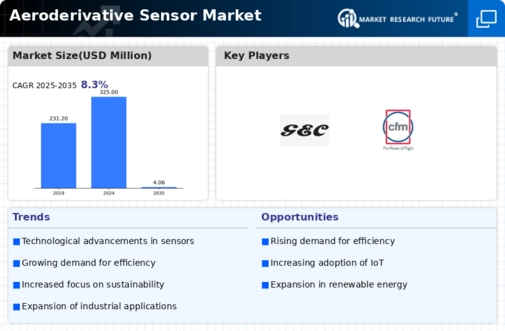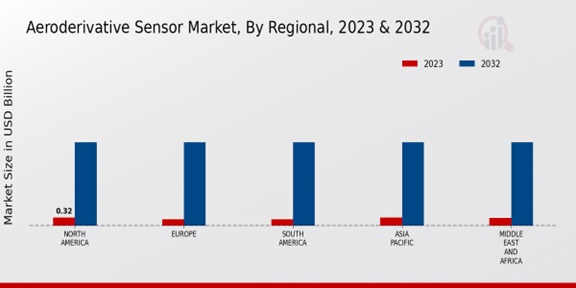Technological Advancements
The Global Aeroderivative Sensor Market Industry is experiencing rapid technological advancements, which are enhancing sensor capabilities and performance. Innovations in materials and manufacturing processes are leading to the development of more efficient and accurate sensors. For instance, the integration of advanced algorithms and machine learning techniques is enabling real-time data processing and analysis. This evolution is crucial as industries increasingly rely on precise measurements for operational efficiency. The market is projected to reach 325 USD Million in 2024, reflecting the growing demand for sophisticated sensor technologies across various sectors.
Increased Investment in R&D
Investment in research and development is a crucial driver for the Global Aeroderivative Sensor Market Industry. Companies are allocating substantial resources to innovate and enhance sensor technologies. This focus on R&D is essential for developing next-generation sensors that meet evolving industry needs. Government initiatives and funding programs aimed at promoting technological advancements further support this trend. As a result, the market is likely to witness a surge in innovative products that improve performance and reliability. This investment is expected to contribute to the overall growth trajectory of the market in the coming years.
Growing Industrial Automation
The Global Aeroderivative Sensor Market Industry is benefiting from the accelerating trend of industrial automation. As industries adopt automated systems, the need for precise and reliable sensors becomes paramount. Aeroderivative sensors are integral to automation processes, providing critical data that enhances operational efficiency and safety. The rise of smart factories and the Internet of Things (IoT) is further propelling this demand. With automation projected to expand significantly, the market is poised for growth, although a CAGR of -32.85% is expected from 2025 to 2035, indicating potential market fluctuations.
Rising Demand for Energy Efficiency
In the context of the Global Aeroderivative Sensor Market Industry, the increasing emphasis on energy efficiency is a significant driver. Industries are actively seeking solutions that minimize energy consumption and reduce operational costs. Aeroderivative sensors play a pivotal role in monitoring and optimizing energy usage in power generation and manufacturing processes. As organizations strive to meet sustainability goals, the demand for these sensors is expected to surge. This trend aligns with the projected growth of the market, which is anticipated to reach 4.06 USD Million by 2035, indicating a robust shift towards energy-efficient technologies.
Regulatory Compliance and Safety Standards
The Global Aeroderivative Sensor Market Industry is significantly influenced by stringent regulatory compliance and safety standards. Industries are compelled to adopt advanced sensor technologies to meet regulatory requirements and ensure operational safety. Aeroderivative sensors provide accurate monitoring and data collection, which are essential for compliance with environmental and safety regulations. As regulations become more rigorous, the demand for these sensors is likely to increase. This trend underscores the importance of reliable sensor technologies in maintaining compliance and enhancing safety across various sectors.














Leave a Comment